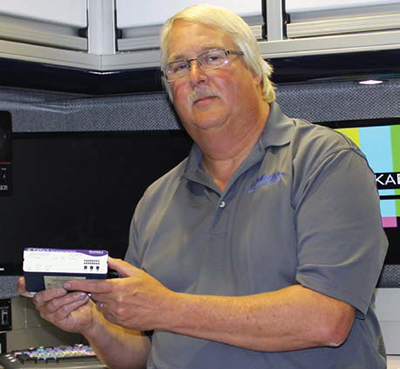Ensemble BrightEye Perfect Fit at Frontline

Jeff Steele and the Ensemble Designs BrightEye 56
CLEARWATER, FLA.—Frontline Communications has been designing and building custom vehicles for ENG, satellite uplink/downlink and mobile field operations since 1985 and we’ve seen a lot of changes in the industry since producing our first vehicle.
One of the biggest of these was the evolution of the ENG and DSNG markets to digital.
SDI brought with it the requirement for a new breed of test signal generator to complement these digital designs.
Early on in the transition we used the same “old school” broadcast facility generators. However, the to get the needed feature set took a lion’s share of the equipment budget. In addition, many of these units weren’t up to the rigors of day-to-day operation in a news vehicle. With constant power cycling, voltage fluctuations, vibration and temperature extremes, reliability became an issue.
Also, the systems we were designing needed to be format-friendly, as many stations didn’t have the budget to convert cameras, microwave and encoder equipment all at once. What we needed was a low-cost, high-quality generator with a feature set that supported digital and analog operations.
I have to admit that when Ensemble’s BrightEye 56 appeared on the market I was skeptical that it would be up to the task. It was vastly different from what I’d come to expect in a test generator, and at only 1/3 the width of rackspace and less than six inches deep, it didn’t appear to have enough real estate to contain the circuitry needed for the job. However, we soon learned that its small size and weight belied its capabilities and design features.
It weighs less than two pounds (a real plus in mobile installations) and comes with a rackmount shelf that needs no rear support (another plus that lowers installation costs). The BrightEye’s simple and intuitive front panel layout features just three pushbuttons to provide control of most functions needed in day-to-day operations. And these buttons have a good tactical feel—no membrane switches here!
Operation is simple with the mode switch toggling desired functions and the left-right switches changing settings. The changes are instant with no lag and front panel LED indicators make it easy to determine setup.
EASY CUSTOMIZATION OF SIGNALS
A configuration program sets up functions not available on the front panel. Once this is installed on your laptop, it’s a simple matter of connecting to the BrightEye’s rear USB port and letting the program self-discover the unit and bring up the appropriate configuration pages.
We typically use this feature for setting the slate verbiage, audio attributes, and also activating the “Cyclops” function to add a motion element to test signals, something that’s very handy for transmission applications.
The big plus that makes BrightEye appropriate for mixed format systems is the inclusion of a full complement of analog and digital signals. We’ve yet to find any other test generator that matches the features available in the BrightEye 56 and to date, we’ve installed more than 250 units in news vehicles. The device has proven to be been reliable, cost effective, and is a great tool for our systems designs.
Jeff Steele is a 30-year broadcast industry veteran. He may be contacted atjsteele@frontlinecomm.com.
For additional information, contact Ensemble Designs at 530-478-1830 or visitwww.ensembledesigns.com.
Get the TV Tech Newsletter
The professional video industry's #1 source for news, trends and product and tech information. Sign up below.
